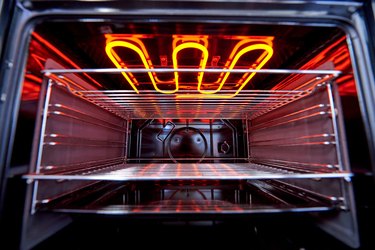
Whenever they see fire where it shouldn't be, most people have a natural instinct to douse it with water. That's a big mistake with kitchen fires, because they usually involve burning grease or electrical elements, and water makes these fires worse. Water conducts electricity and causes burning grease to form steam and splatter, both of which cause the fire to spread.
When you have an oven element on fire, the safest way to put the kitchen fire out is with a fire extinguisher. But not just any fire extinguisher: it must be rated B or K for grease fires and C for electrical fires. Fire Extinguisher Depot advises that almost all fire extinguishers are rated for these, as well as Class A fires, which are those caused by burning wood or paper.
Video of the Day
Video of the Day
ABC Fire Extinguishers — Absolute Necessity
Most hardware stores and big box stores, such as Lowes and Home Depot, stock fire extinguishers. But before you purchase one, check the label, which displays the ratings. A good all-purpose fire extinguisher for your kitchen displays the letters A, B and C, which means the extinguisher will put out wood, grease and electrical fires. If you have a commercial kitchen, you should also have a Class K fire extinguisher, which is specifically designed for animal and vegetable oil fires.
Fire extinguishers need periodic maintenance, which includes checking the pressure and recharging it if necessary. If your fire extinguisher is in good shape, you'll be able to pull the pin, point it at the fire while standing about 6 feet away and pull the trigger to eject the material. Note that once you pull the trigger, you must have the extinguisher professionally recharged before using it again.
Oven Coil Fires — Alternative Responses
If you don't have a fire extinguisher in the kitchen, you still need to put out the fire, and you can often do this by simply closing the oven door, according to Spoon University. This deprives the fire of oxygen, and it should soon go out. You can also toss baking soda on the fire, which is a better way to treat an electrical fire than closing the door, but it still isn't enough.
When there is an oven coil sparking, the sparks may ignite grease on the element. Baking soda will put out the grease fire, but it won't stop the sparking. That's why it's important to pull the plug or shut off the breaker as soon as possible. Once the sparking stops, you can handle the grease fire by spreading baking soda or closing the door.
Blown Oven Elements
After an oven fire, you usually have to clean or replace the element. It probably already had a short, which is why it was sparking. But even if it didn't, it's now charred and is in no condition to cook your food. If a replacement is required, you may have to shop around, because oven elements are model-specific, which means you won't be able to use the oven until you find a new one.
Follow the manufacturer's instructions to replace the element. It's usually a matter of shutting off the power, loosening some screws, disconnecting some wires, pulling the old element off its plug-like connector and reversing the procedure to install the new one. If the element is only charred by burning grease, remove it, wash it in the sink and let it dry thoroughly before replacing it.